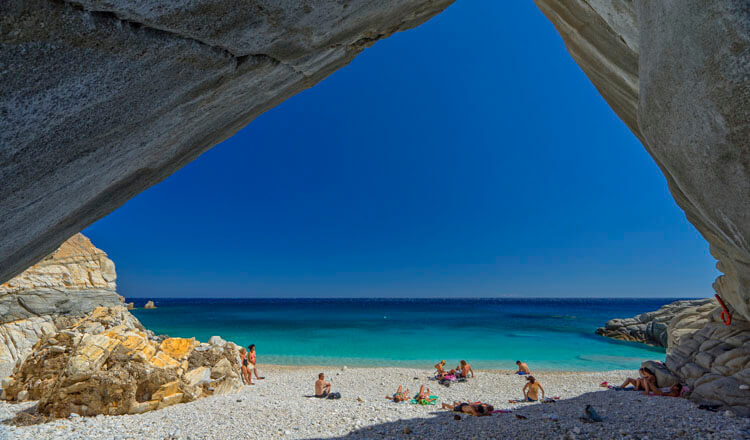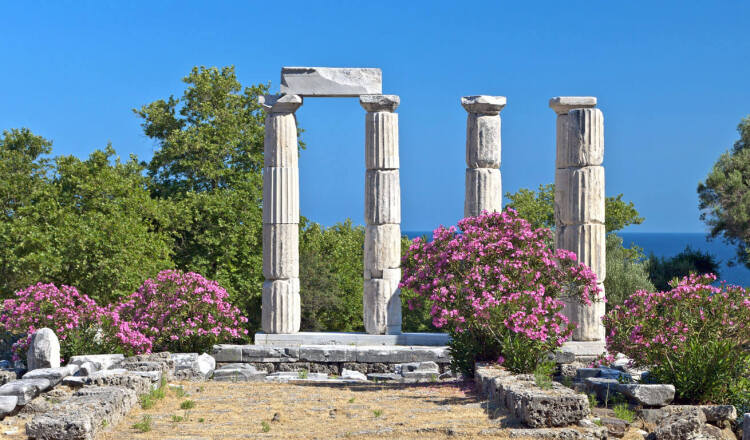Mytilene is one of Greece’s oldest city-states. It is built over seven hills and is Lesvos capital. The traditional houses and neoclassical structures, the Byzantine churches and the ancient monuments are well worth a walk around the town.
The Byzantine castle dominates the city and besides its walls that still stand tall, you will come across underground arcades, Gattilusios coat of arms and a number of Ottoman monuments. Go by the old aristocratic Kioski neighbourhood located below the castle and catch a glimpse of the magnificent neoclassical stately houses. At the old northernmost harbour, Epano Skala, see numerous Ottoman structures (Geni Tzami Mosque, Baths etc) as well as historic refugee neighbourhoods.
Don’t miss the old agora located around Ermou and the surrounding streets. Also see Agios Therapontos (1850), one of the largest churches on the island with a 40 metre tall dome, built on the site of Ancient Asclepios.
Mytilene has a large number of Museums to visit such as the Archaeological Museum with the mosaic floors and murals, as well as the Ecclesiastical Byzantine Museum that showcases wood carved artefacts, icons, sacred vessels and silversmithing artwork.
Head to Vareia (4 km north) for a stop by the Museum of Theophilos, showcasing 86 paintings by the local artist Stratis Eleftheriadis, as well as the Museum – Library Stratis Eleftheriadis – Tériade, which displays a large number of books and paintings. Within the latter museum you can see artworks by Marc Chagall, Henri Matisse, Pablo Picasso, Fernand Léger, Theophilos and other significant Greek and foreign artists.
Stop by the ancient theatre (used to hold up to 15,000 people) and the nearby neighbourhood of Chorafa, where you can see the Roman Villa of Menandros with its astounding mosaics. Look ip the southernmost side where the picturesque Makry Gialo suburb is and see an Early Christian burial structure as well as an ancient roman fish farm. Don’t miss the suburbs of Soufada and Akleidiou (2 km south) with their stately houses and the Church of Panagia.
Excursions
Visit Skala Loutron (7,5 km SW), built on a hillside on the gulf of Gera, surrounded by a green area with olive trees. Stop by the French cemetery dating back to WW1 and the thermal springs (water temp: 39.5° C) ideal in treating rheumatism, arthritis and more.
The wider area of Thermi (13 km NW) is built in a green landscape. Go to Paralia Thermi with its renowned hot springs or the famous Pyrgi Thermi where there are numerous traditional houses dating back to the 18th and 19th century. Visit the charming village of Loutropoli Thermi with its fine market and cafes, the Monastery of Saint Raphael where the saints’ holy relics lie (2.5km south), the ancient hot springs and walls at Petralona, as well as the Byzantine church of Panagia Troulotis (Virgin Mary) with its 18th c. wood carved icon.
On the NE side of Mount Olympus stop by Agiasos located among pine, chestnut and olive trees. The cobblestone alleys and the colourful houses with the traditional bay windows (sachnisi) are a sight for sore eyes. Agiasos also holds on to the tradition of woodcarving and pottery art.
The stone built houses and stately homes make Eressos a delightful destination. Philosophers Theophrastos and Phanias as well as the poet Sappho were native to Eressos. Sappho is honored by lesbian women who come here from around the world every year, and a school housed in an amazing neoclassical building was named after Theophrastos. Don’t miss Skala Eresou, the seaside part of the village, where you can enjoy its vivid nightlife.
Pay a visit to the seaside village of Sigri and the Natural History Museum of the Lesvos Petrified Forest as well as the remarkable Petrified Forest, which extends from Sigri to Eressos and to Antissa.
Mantamados, the religious centre of the island, is a village with interesting architecture and a tradition in wood carving and pottery art. Go by the Monastery and Church of Taxiarchis, which showcases an 800 years old icon, 2 metres high, of the Archangel Michael of Mantamados made with wax.
The island town of Agia Paraskevi (named after the chapel found in a cave) is where you can visit the Museum of Industrial Olive-Oil Production of Lesvos that presents the industrial phase of olive-oil production and is housed in the old communal olive press.
The seaside town of Kalloni is surrounded by fertile valleys renowned for its exquisite sweet red wine and sardines. Ancient finds and Byzantine monuments located here are proof of the area’s glorious past and the existence of the ancient cities of Pyrra (relics found in the sea bottom) and Arisvi (ruins of temples and Byzantine castles).
The traditional village of Sikaminia (aka Sykamia) is built on Mount Lepetymnos in a lush landscape on the NE end of Lesvos and has an awesome sea view. Sykamia was the hometown of Stratis Myrivilis, a famous Greek writer.
Head to Petra (meaning rock in Greek) named after the huge 27 metres high boulder found in the centre of the hamlet and see the church of Panagia Glykophilousa on the very top, a listed structure, built in 1747 and restored in 1840.
Molyvos or Mithymna is built on the side of a steep hill and is one of the most charming villages around Greece. Enjoy its architecture with its stone built houses, colourful bay windows and ottoman fountains. Overlooking the village from the top is the castle, which dates back to the 13th c. and was restored by the Gattilusi.
The second biggest town on the island is Plomari with 3,500 inhabitants. It experienced phenomenal growth in the beginning of the 20th c., before the Greek-Turkish war (1922), when they used to operate olive presses, tanneries, distilleries, soap factories and olive pit refineries.
The most famous village on Lesvos is Vatera, known for its long sandy beach that stretches down to Cape Agios Fokas, where there is a church with the same name and ruins of an early Christian basilica as well as relics of the temple of Dionysos.





















